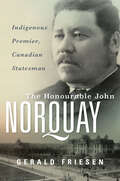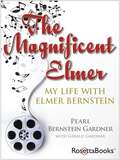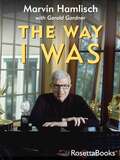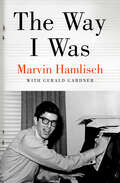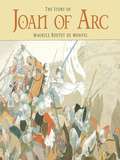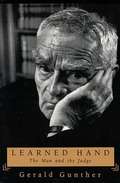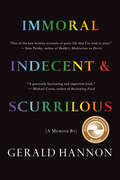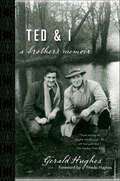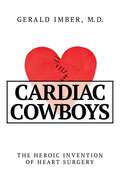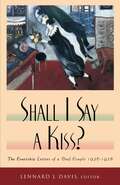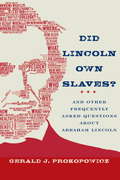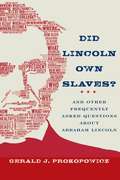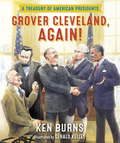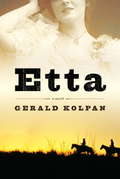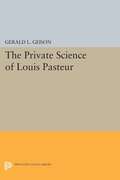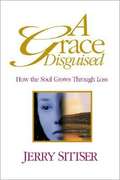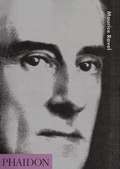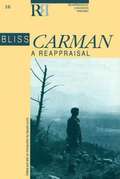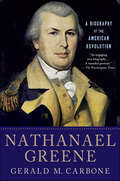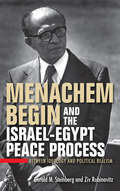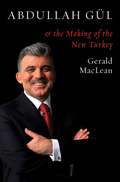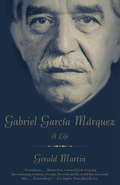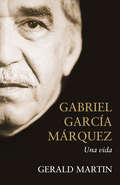- Table View
- List View
The Honourable John Norquay: Indigenous Premier, Canadian Statesman
by Gerald FriesenThe life and times of the Premier from Red River John Norquay, orphan and prodigy, was a leader among the Scots Cree peoples of western Canada. Born in the Red River Settlement, he farmed, hunted, traded, and taught school before becoming a legislator, cabinet minister, and, from 1878 to 1887, premier of Manitoba. Once described as Louis Riel’s alter ego, he skirmished with prime minister John A. Macdonald, clashed with railway baron George Stephen, and endured racist taunts while championing the interests of the Prairie West in battles with investment bankers, Ottawa politicians, and the CPR. His contributions to the development of Canada’s federal system and his dealings with issues of race and racism deserve attention today. Recounted here by Canadian historian Gerald Friesen, Norquay’s life story ignites contemporary conversations around the nature of empire and Canada’s own imperial past. Drawing extensively on recently opened letters and financial papers that offer new insights into his business, family, and political life, Friesen reveals Norquay to be a thoughtful statesman and generous patriarch. This masterful biography of the Premier from Red River sheds welcome light on a neglected historical figure and a tumultuous time for Canada and Manitoba.
The Magnificent Elmer
by Gerald Gardner Pearl Bernstein GardnerBorn in New York City in 1922, Elmer Bernstein was one of America's most celebrated composers--best known for the award-winning musical scores he developed for film, theatre, and television over a fifty-year career. His best-known work includes the scores he wrote for The Great Escape, The Magnificent Seven, To Kill a Mockingbird, Ghostbusters, and The Ten Commandments, among many others. He was nominated for fourteen Oscars, winning one for the score to Thoroughly Modern Millie in 1967. He was also nominated for two Grammy Awards and won two Golden Globe awards.This debut memoir by Pearl Bernstein Gardner, his wife of twenty years, Galatea to his Pygmalion, provides a sweeping account of the great composer's life--from their time together as newlyweds living in a fifth-floor New York City walk-up to the glamour of the red carpet and the intrigues of Hollywood during the turbulent McCarthy period. The Bernsteins were also close friends with many prominent musicians, actors, directors, and writers of the day, including Frank Sinatra, Clifford Odets, Danny Kaye, Otto Preminger, and Cecil B. DeMille--and the portraits of their intimate conversations are both poignant and memorable.
The Way I Was
by Marvin Hamlisch Gerald GardnerMarvin Hamlisch got his start as a rehearsal pianist for Funny Girl with Barbra Streisand, and went on to co-create A Chorus Line, write the Oscar-winning musical score for The Way We Were, and win many other awards for the music he wrote for the stage and screen. Hamlisch is one of only a handful of people to win a Grammy, a Tony, an Oscar, and an Emmy. In this revealing autobiography, written in partnership with noted freelance writer Gerald C. Gardner, Hamlisch tells the story of his childhood, his marriage, and his friendships with stars including Liza Minnelli, Barbra Streisand, and Groucho Marx. The autobiography paints a nostalgic and intimate picture of Broadway and Hollywood. After his death in 2012, Barbra Streisand made a tribute to him in her appearance on the 2013 Oscar broadcast. This book includes moving words from Hamlisch's many celebrity friends during the memorial service held shortly after his death. ABOUT THE AUTHOR Marvin Hamlisch (1944-2012) was an award-winning American composer and conductor. Born in Manhattan to Viennese Jewish parents, Hamlisch was a child prodigy, and was admitted into the Juilliard School at the age of seven. He wrote his first Billboard Hot 100 song at the age of 21. Hamlisch wrote music for several early Woody Allen films, The Spy Who Loved Me, The Way We Were, and the original theme music for Good Morning America--among many other compositions. He also served as Principal Pops Conductor for the Pittsburgh Symphony Orchestra, the Milwaukee Symphony Orchestra, the San Diego Symphony, the Seattle Symphony, and several others. He is one of only a handful of people in the world to win an Emmy, Grammy, Oscar, and Tony. He also won two Golden Globes and a Pulitzer Prize. Hamlisch was awarded the Lifetime Achievement Award at the World Soundtrack Awards in 2009. Gerald C. Gardner is an author, scriptwriter, producer, and screenwriter. He is the author of 22 episodes of The Monkees and 11 episodes of Get Smart, several of which were nominated for Primetime Emmy Awards. He was also a senior writer for the series of live news satire broadcasts That Was the Week That Was. He is also the author of over 30 books.
The Way I Was
by Marvin Hamlisch Gerald GardnerThe EGOT-winning composer of The Way We Were and A Chorus Line recounts his remarkable life from childhood to Broadway and Hollywood. The son of Jewish Viennese immigrants, six-year-old Marvin Hamlisch&’s early musical talent and discipline led him to Julliard, where he studied for more than a decade. From there, Hamlisch got his start as a rehearsal pianist for Funny Girl starring Barbra Streisand. He went on to co-create the classic American musical A Chorus Line and wrote the Oscar Award–winning musical score for The Way We Were. Hamlisch is one of only a handful of people to achieve EGOT status—winning an Emmy, a Grammy, an Oscar, and a Tony. In this autobiography, Hamlisch tells the tale of his life and career, revealing personal stories of his childhood, his marriage, and his friendships with stars including Liza Minnelli, Groucho Marx, and others. It offers an intimate view of his life and a compelling portrait of Broadway and Hollywood through the second half of the twentieth century.
The Story of Joan of Arc
by Gerald Gottlieb Maurice Boutet de MonvelHer story is legendary, but it happens to be true: nineteen-year-old Joan of Arc led armies into battle during the Hundred Years War and helped liberate France from English domination. One of the most famous children's books ever published, this elegant work recounts Joan's wondrous transformation from peasant girl to military commander to Christian saint and martyr. Generations of artists and writers from around the world have drawn inspiration from Joan's life, and she remains among the best-known historical figures of the Middle Ages. Maurice Boutet de Monvel's simple but moving retelling of her story features a series of imaginative illustrations that won the artist international fame. All forty-five of the images from his 1896 deluxe picture book appear here in full color, reflecting the saint's enduring symbolic power as well as her deep humanity. An Introduction by Gerald Gottlieb is included in this edition.
Learned Hand: The Man and the Judge
by Gerald GuntherA powerfully moving account of the life of one of the great judges of the twentieth century, whose work has left a profound mark on our legal, intellectual, and social landscape. The greatest judge never to be appointed to the Supreme Court, he is widely considered to be the peer of Justices Holmes, Brandeis, and Cardozo.
Immoral, Indecent, and Scurrilous: The Making of an Unrepentant Sex Radical
by Gerald Hannon“At least by reputation, I am a sex radical: gay activist dating back to the Cretaceous, defender of pedophiles, defender of (and participant in) sex work, sometime porn actor and maker, shameless voyeur (no window is safe if my binoculars are at hand), perpetual sour-puss on the subject of gay marriage. I came of age in the 1960s and ’70s, an era when most of those character traits and activities would have been seen as illegal at worst and shameless at best. Some still are. Others — gay marriage, for example — have switched sides, transitioning from what many people thought of as an unthinkable and illegal travesty to a ritual celebrated in a growing number of jurisdictions, Canada included.” When 18-year-old Gerald Hannon left the small pulp mill town of Marathon, Ontario to attend the University of Toronto, he never would have predicted he’d become part of LGBTQ2S+ history. Almost sixty years later, he reflects on the major moments in his career as a journalist and LGBTQ2S+ activist. From the charges of transmitting immoral, indecent, and scurrilous literature laid against him and his colleagues at The Body Politic to his dismissal from his teaching post at Ryerson University for being a sex worker, this memoir candidly chronicles Hannon’s life as an unrepentant sex radical.
Ted & I: A Brother's Memoir
by Gerald HughesAnecdotal and immensely charming, Ted and I is a unique portrait of a shared childhood between Gerald Hughes and his younger brother Ted, one of the finest and best-loved poets of modern times. Ted's love for Gerald was probably one of the most enduring and sustaining forces in his life. Hughes brings alive a period when the two brothers would roam the countryside, camping, making fires, pitching tents, hunting rabbits, rats, wood pigeon and stoats. Ted's fascination with all wildlife subsequently fed directly into his sublime poetry. Gerald describes watching his brother evolving into a great poet and describes them continuing their relationship, even when many miles apart. Containing a great many unique and never-before seen family photographs of Ted Hughes, as well as unpublished material, this extraordinary memoir is an achingly poignant tale of childhood and youth and togetherness; the tenderness of brotherly love and the development of a poetic mind as Hughes went into the air force, on to Cambridge where he published his first poems and met Sylvia Plath, before settling in Devon with Sylvia, where their children were born. Ted and I also features a foreword by Gerald's niece Frieda Hughes, the daughter of Ted Hughes and Sylvia Plath and herself a well-known painter and poet.
Cardiac Cowboys: The Heroic Invention of Heart Surgery
by Gerald ImberCardiac Cowboys is the dramatic story of five deeply flawed geniuses who together—and in competition with each other—invented open-heart surgery against all conventional medical wisdom and saved millions of lives.A decade after World War II, there was still no such thing as open-heart surgery, and yet half a million Americans were dying from heart disease every year. One in a hundred children would suffer and die from congenital heart disease as well, and doctors did little other than predict their deaths. After the first daring operation in 1954 and through the next three decades, five heroic surgeons braved the scorn of their peers, withstood fierce desperation, and faced possible death in order to devise procedures that would save overwhelming numbers of those doomed children and provide hope for a new life to all manner of heart-failing individuals. Devising and mastering heart transplants and bypass surgery, they invented artificial heart valves, the lifesaving pacemaker, and worked toward the holy grail of an artificial heart as their private and professional lives imploded. The story of the Cardiac Cowboys, their outsized personalities, and often self-destructive behavior is a saga more thrilling and exhilarating than fiction.
Shall I Say A Kiss?: The Courtship Letters of a Deaf Couple, 1936-1938
by Lennard J. Davis Gerald J. DavisUpon the death of his father Morris at age 82, Lennard Davis found among his effects a trove of letters, kept in careful chronological order, that dated from 1936. The letters ended in 1938, when Eva Weintrobe came to America to marry Morris, and they provide the core of Shall I Say A Kiss?, their courtship by correspondence. In his framing comments, Davis speculates that his parents met perhaps four or five times before they wed, a fact that heightens the importance of these letters to their fate. Davis illustrates vast contrasts between Morris and Eva, both to each other (Morris was 38; Eva was 26), and to themselves in later life as witnessed by their son. Where Davis saw his father brimming with confidence and a sense of superior intellect while his mother acted as the reserved, dutiful wife, he was startled to learn through their letters that she could be the shrewd questioning correspondent even as his father wrote as an unsure, imploring suitor. Shall I Say A Kiss? opens a window into the lives of two working-class, Jewish, British, Deaf people in the 1930s. This striking book reveals a consistent, journal-like account of the “lived” experience of Deaf people during the tumultuous times just prior to World War II. Because the correspondence is mainly composed of Eva’s letters, the focus sharpens even further as a record of the life and opinions of a young, working-class, Deaf woman about to embark upon marriage and life in a new country. The challenges she faced, including de facto racial barriers for both deaf and Jewish immigrants, and the prospect of uniting with a man she knew mostly through his letters alone, make for a compelling and emotional trip through her life. Shall I Say A Kiss? serves as a singular social document and also as an engaging and often moving narrative that will win audiences among academics and romantics alike.
Did Lincoln Own Slaves?
by Gerald J. ProkopowiczIn the bicentennial year of Lincoln's birth, here is the one indispensable book that provides all you need to know about our most revered president in a lively and memorable question-and-answer format.You will learn whether Lincoln could dunk a basketball or tell a joke. Was he the great emancipator or a racist? If he were alive today, could he get elected? Did he die rich? Did scientists raise Lincoln from the dead? From the seemingly lighthearted to the most serious Gerald Prokopowicz tackles each question with balance and authority, and weaves a complete, satisfying biography that will engage young and old, scholars and armchair historians alike.From the Trade Paperback edition.tion?) or from today's tabloids (Did doctors really raise Lincoln from the dead?), the questions in Did Lincoln Own Slaves? illuminate what people really want to know about the past.Prokopowicz has organized the questions along the time line of Lincoln's life to give us a portrait of the sixteenth president unlike any we have had before. His authoritative, often surprising responses illuminate facets of Lincoln's life, work, and legacy about which people remain endlessly curious.From the Hardcover edition.
Did Lincoln Own Slaves?: And Other Frequently Asked Questions about Abraham Lincoln
by Gerald J. ProkopowiczOver the course of nine years as scholar-in-residence at the Lincoln Museum, Gerald J. Prokopowicz answered thousands of questions about Abraham Lincoln. Reporters, researchers, students, and especially the 50,000 visitors who come to the museum every year all want to know about the nation's most famous president. Although there have been more books written about Lincoln than any other American, there has never been a single book that clearly answers the most important, most unusual, most provocative, and most frequently asked questions. Until now. Did Lincoln Own Slaves? And Other Frequently Asked Questions About Abraham Lincolndraws on the questions that people actually ask. Some are personal: Did Lincoln keep an pets? Some are inspired by recent reinterpretations of Lincoln's actions: Was Lincoln a racist? Some are questions that previous generations of historians considered inappropriate: Was Lincoln gay? Whether drawn from today's headlines (Did Lincoln's presidential actions violate the Constitution?) or from today's tabloids (Did doctors really raise Lincoln from the dead?), the questions inDid Lincoln Own Slaves?illuminate what people really want to know about the past. Prokopowicz has organized the questions along the time line of Lincoln's life to give us a portrait of the sixteenth president unlike any we have had before. His authoritative, often surprising responses illuminate facets of Lincoln's life, work, and legacy about which people remain endlessly curious.
Grover Cleveland, Again!: A Treasury of American Presidents
by Ken Burns Gerald KelleyA gorgeous collection of American presidents filled with fun facts and sparkling with personality, from nonfiction master Ken Burns. This special treasury from America's beloved documentarian Ken Burns brings the presidents to life for our nation's children. Each president is given a lushly illustrated spread with curated stories and information to give readers of all ages a comprehensive view of the varied and fascinating characters who have led our nation (with the exception of Grover Cleveland--the only president to serve two non-consecutive terms--who gets two spreads!). A must-have for Ken's many fans, classrooms, and anyone who wishes to gain a greater understanding and appreciation for our country. "A buoyant gallery, up to date, handsomely framed, and, in this particular election year, timely too."--Kirkus ReviewsFrom the Hardcover edition.
Etta: A Novel
by Gerald KolpanBeautiful, elusive, and refined, Etta Place captivated the nation at the turn of the last century as she dodged the law with the Wild Bunch, led by Butch Cassidy and the Sundance Kid. Her true identity and fate have remained a mystery that has tantalized historians for decades. Now, for the first time, Gerald Kolpan envisions this remarkable woman’s life in a stunning debut novel.Kolpan imagines that Etta Place was born Lorinda Jameson, the daughter of a prominent financier, who becomes known as the loveliest of the city’s debutantes when she makes her entrance into Philadelphia society. Though her position in life is already assured, her true calling is on horseback. She can ride as well as any man and handle a rifle even better. But when a tragedy leads to a dramatic reversal of fortune, Lorinda is left orphaned, penniless, homeless, and pursued by the ruthless Black Hand mafia.Rechristened “Etta Place” to ensure her safety, the young woman travels to the farthest reaches of civilization, working as a “Harvey Girl” waitress in Grand Junction, Colorado. There, fate intervenes once more and she again finds herself on the run from the ruthless Pinkerton Detective Agency. But this time she has company. She soon finds herself at the legendary hideout at Hole-in-the-Wall, Wyoming, where she meets the charismatic Butch Cassidy and the handsome, troubled Harry Longbaugh, a.k.a. the Sundance Kid. Through a series of holdups and heists, Etta and Harry begin an epic and ultimately tragic romance, which will be the greatest of Etta’s life. Then, when Etta meets the young and idealistic Eleanor Roosevelt, her life is changed forever.Blending a compelling love story, high adventure, and thrilling historical drama, Etta is an electrifying novel. With a sweeping 1900s setting, colorful storytelling, and larger-than-life characters, Etta is debut that is both captivating and unforgettable.From the Hardcover edition.
The Private Science Of Louis Pasteur (Princeton Legacy Library)
by Gerald L. GeisonIn The Private Science of Louis Pasteur, Gerald Geison has written a controversial biography that finally penetrates the secrecy that has surrounded much of this legendary scientist's laboratory work. Geison uses Pasteur's laboratory notebooks, made available only recently, and his published papers to present a rich and full account of some of the most famous episodes in the history of science and their darker sides--for example, Pasteur's rush to develop the rabies vaccine and the human risks his haste entailed. The discrepancies between the public record and the "private science" of Louis Pasteur tell us as much about the man as they do about the highly competitive and political world he learned to master. Although experimental ingenuity served Pasteur well, he also owed much of his success to the polemical virtuosity and political savvy that won him unprecedented financial support from the French state during the late nineteenth century. But a close look at his greatest achievements raises ethical issues. In the case of Pasteur's widely publicized anthrax vaccine, Geison reveals its initial defects and how Pasteur, in order to avoid embarrassment, secretly incorporated a rival colleague's findings to make his version of the vaccine work. Pasteur's premature decision to apply his rabies treatment to his first animal-bite victims raises even deeper questions and must be understood not only in terms of the ethics of human experimentation and scientific method, but also in light of Pasteur's shift from a biological theory of immunity to a chemical theory--similar to ones he had often disparaged when advanced by his competitors. Through his vivid reconstruction of the professional rivalries as well as the national adulation that surrounded Pasteur, Geison places him in his wider cultural context. In giving Pasteur the close scrutiny his fame and achievements deserve, Geison's book offers compelling reading for anyone interested in the social and ethical dimensions of science. Originally published in 1995. The Princeton Legacy Library uses the latest print-on-demand technology to again make available previously out-of-print books from the distinguished backlist of Princeton University Press. These editions preserve the original texts of these important books while presenting them in durable paperback and hardcover editions. The goal of the Princeton Legacy Library is to vastly increase access to the rich scholarly heritage found in the thousands of books published by Princeton University Press since its founding in 1905.
A Grace Disguised: How the Soul Grows Through Loss
by Gerald L. SittserIn an instant, an accident took the author's mother, wife and young daughter. How can we begin with a new life, one with joy, depth and compassion?
Maurice Ravel (20TH-CENTURY COMPOSERS)
by Gerald LarnerFrom the Pavane pour une Infante défunte to Boléro, much of the music of Maurice Ravel (1875-1937) is among the most accessible of any written during the last hundred years. The man, however, was notoriously difficult to get to know, partly because of his inherent reserve and partly because he concealed aspects of his character even from his closest friends. The author aims to trace the development of the composer's personality not only through events in his life and in the society around him but also through his music, which is more revealing in this respect than is generally believed. Ravel tended to reveal most of himself at times of crisis, such as the outbreak of World War I, and the death of his adored mother in 1917. 'Adversity', the chapter devoted to those years, is a central feature in a book which begins by evaluating the importance of Ravel's mixed Basque and Swiss heredity and then pursues the first part of his life through his childhood in Bohemian Montmartre, his controversial activities as a student at the Paris Conservatoire, and the establishment of his career as a composer fascinatingly interlinked with that of his older contemporary Claude Debussy. A moving description of his war service as a truck driver is followed by an account of the slow recovery from the failure in his health and morale after his mother's death, the period of conflict and reconciliation with the post-war movement represented by Erik Satie and Les Six, and a last decade of international celebrity coinciding with the gradual onset of the illness which silenced him four years before his death.
Bliss Carman: A Reappraisal
by Gerald LynchThe tarnished reputation of this turn-of-the-century poet is persuasively burnished anew by fifteen scholars, editors, and poets.
Nathanael Greene: A Biography of the American Revolution
by Gerald M. CarboneThe intriguing life story of an unsung hero of the American Revolution from award-winning author Gerald M. Carbone. When the Revolutionary War began, Nathanael Greene was a private in the militia, the lowest rank possible, yet he emerged from the war with a reputation as George Washington's most gifted and dependable officer--celebrated as one of three most important generals. Upon taking command of America's Southern Army in 1780, Nathanael Greene was handed troops that consisted of 1,500 starving, nearly naked men. Gerald Carbone explains how within a year, the small worn-out army ran the British troops out of Georgia, South Carolina, and North Carolina and into the final trap at Yorktown. Despite his huge military successes and tactical genius Greene's story has a dark side. Gerald Carbone drew on 25 years of reporting and researching experience to create his chronicle of Greene's unlikely rise to success and his fall into debt and anonymity.
AIDS Doctors: An Oral History
by Ronald Bayer Gerald M. OppenheimerToday, AIDS has been indelibly etched in our consciousness. Yet it was less than twenty years ago that doctors confronted a sudden avalanche of strange, inexplicable, seemingly untreatable conditions that signaled the arrival of a devastating new disease. Bewildered, unprepared, and pushed to the limit of their diagnostic abilities, a select group of courageous physicians nevertheless persevered. This unique collective memoir tells their story. <p><p> Based on interviews with nearly eighty doctors whose lives and careers have centered on the AIDS epidemic from the early 1980s to the present, this candid, emotionally textured account details the palpable anxiety in the medical profession as it experienced a rapid succession of cases for which there was no clinical history. The physicians interviewed chronicle the roller coaster experiences of hope and despair, as they applied newly developed, often unsuccessful therapies. Yet these physicians who chose to embrace the challenge confronted more than just the sense of therapeutic helplessness in dealing with a disease they could not conquer. They also faced the tough choices inherent in treating a controversial, sexually and intravenously transmitted illness as many colleagues simply walked away. Many describe being gripped by a sense of mission: by the moral imperative to treat the disempowered and despised. Nearly all describe a common purpose, an esprit de corps that bound them together in a terrible yet exhilarating war against an invisible enemy. <p> This extraordinary oral history forms a landmark effort in the understanding of the AIDS crisis. Carefully collected and eloquently told, the doctors' narratives reveal the tenacity and unquenchable optimism that has paved the way for taming a 20th-century plague.
Menachem Begin and the Israel-Egypt Peace Process: Between Ideology and Political Realism (Perspectives On Israel Studies)
by Gerald M. Steinberg Ziv RubinovitzThis political biography sheds new light on the vital role played by the Israeli Prime Minister in establishing peaceful relations with Egypt.Focusing on the character and personality of Menachem Begin, Gerald Steinberg and Ziv Rubinovitz offer a new look into the peace negotiations between Israel and Egypt in the 1970s. Begin’s role as a peace negotiator has often been marginalized, but this sympathetic and critical portrait restores him to the center of the diplomatic process. Beginning with the events of 1967, Steinberg and Rubinovitz look at Begin’s statements on foreign policy, including relations with Egypt, and his role as Prime Minister and chief signer of the Israel-Egypt peace treaty. While Begin did not leave personal memoirs or diaries of the peace process, Steinberg and Rubinovitz have tapped into newly released Israeli archives and information housed at the Jimmy Carter Presidential Library and the Begin Heritage Center. The analysis illuminates the complexities that Menachem Begin faced in navigating between ideology and political realism in the negotiations towards a peace treaty that remains a unique diplomatic achievement.
Menachem Begin and the Israel-Egypt Peace Process: Between Ideology and Political Realism (Perspectives on Israel Studies)
by Gerald M. Steinberg Ziv RubinovitzThis political biography sheds new light on the vital role played by the Israeli Prime Minister in establishing peaceful relations with Egypt.Focusing on the character and personality of Menachem Begin, Gerald Steinberg and Ziv Rubinovitz offer a new look into the peace negotiations between Israel and Egypt in the 1970s. Begin’s role as a peace negotiator has often been marginalized, but this sympathetic and critical portrait restores him to the center of the diplomatic process. Beginning with the events of 1967, Steinberg and Rubinovitz look at Begin’s statements on foreign policy, including relations with Egypt, and his role as Prime Minister and chief signer of the Israel-Egypt peace treaty. While Begin did not leave personal memoirs or diaries of the peace process, Steinberg and Rubinovitz have tapped into newly released Israeli archives and information housed at the Jimmy Carter Presidential Library and the Begin Heritage Center. The analysis illuminates the complexities that Menachem Begin faced in navigating between ideology and political realism in the negotiations towards a peace treaty that remains a unique diplomatic achievement.
Abdullah Gul And The Making Of The New Turkey
by Gerald MacleanDrawing on original research, including in-depth interviews with President Abdullah Gül himself as well as his wife and close circle of colleagues and friends, this fascinating account offers a portrait of a man who has been at the heart of the political, economic, and cultural developments that have brought Turkey to international prominence in recent years. In 2002 Abdullah Gül’s democratically elected party gained power and challenged Turkey’s political and religious legacy. Shortly after, Gül became a key player in Turkey's attempts to receive an accession date for the European Union. In 2007 he became the first president of Turkey who was also a devout Muslim -- causing political commentators to hail his victory as a "new era in Turkish politics” -- and he has since been a major figure in Turkey’s diplomatic relationships in the Middle East and international political arena. An essential source for students of contemporary Turkish culture and society, Gerald MacLean’s absorbing account of this enigmatic individual is accessible to a wide circle of readers and throws light on important episodes of Turkey’s recent history.
Gabriel García Márquez
by Gerald MartinIn this exhaustive and enlightening biography--nearly two decades in the making--Gerald Martin dexterously traces the life and times of one of the twentieth century's greatest literary titans, Nobel Prize-winner Gabriel García Márquez. Martin chronicles the particulars of an extraordinary life, from his upbringing in backwater Columbia and early journalism career, to the publication of One Hundred Years of Solitude at age forty, and the wealth and fame that followed. Based on interviews with more than three hundred of Garcia Marquez's closest friends, family members, fellow authors, and detractors--as well as the many hours Martin spent with 'Gabo' himself--the result is a revelation of both the writer and the man. It is as gripping as any of Gabriel García Márquez's powerful journalism, as enthralling as any of his acclaimed and beloved fiction.
Gabriel García Márquez: Una vida
by Gerald MartinLa biografía definitiva de García Márquez, una obra extraordinaria fruto de 17 años de trabajo. «Todo escritor con principios debería tener un biógrafo inglés», dijo Gabriel García Márquez sobre este libro en una ocasión. Tras diecisiete años de trabajo, más de trescientas entrevistas y un primer borrador con más de tres mil páginas, Gerald Martin ha logrado estar a la altura de esa frase al escribir una biografía magistral, «tolerada» más que autorizada, y saludada por la crítica como la obra definitiva sobre el gran escritor colombiano, quizá el más influyente en lengua española de los últimos cincuenta años. Un libro que recorre la vida y la obra del escritor más fascinante del siglo XX. Desde los inicios en Aracataca y la fundamental relación con su abuelo, Nicolás Márquez, su infancia y juventud, los inicios como periodista entre Cartagena y Barranquilla, el descubrimiento de Europa, el regreso a América y el impacto dela revolución cubana, su consagración como escritor tras la publicación en 1967 de Cien años de soledad y el Nobel de Literatura en 1982, hasta la actualidad. Por sus páginas desfilan sus amistades políticas y literarias: Castro, González, Clinton, Cortázar, Mutis, Vargas Llosa, Balcells, y sus trayectos vitales: Colombia, Barcelona, México. En resumen, un acontecimiento editorial internacional. Reseñas:«Una obra monumental, precisa, atenta a los datos, pero también muy atmosférica y literaria.»Marta Caballero, El Cultural «Una biografía brillante.»Kirkus Reviews «Una crónica magistral y sensible, equilibrada y juiciosa pero también un emocionante tributo.»Times Literary Supplement
